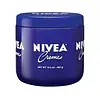What's inside
What's inside
 Key Ingredients
Key Ingredients

No key ingredients
 Benefits
Benefits

 Concerns
Concerns

 Ingredients Side-by-side
Ingredients Side-by-side

CI 16035
Cosmetic ColorantParfum
MaskingButylphenyl Methylpropional
PerfumingBenzyl Alcohol
PerfumingAlpha-Isomethyl Ionone
PerfumingCitronellol
PerfumingLinalool
PerfumingLimonene
PerfumingPhenoxyethanol
PreservativeSodium Hydroxide
BufferingMethylparaben
PreservativeEthylhexylglycerin
Skin ConditioningParaffinum Liquidum
EmollientDimethicone
EmollientTrisodium EDTA
Cera Microcristallina
Emulsion StabilisingC12-15 Alkyl Benzoate
AntimicrobialAcrylates/C10-30 Alkyl Acrylate Crosspolymer
Emulsion StabilisingTocopheryl Acetate
AntioxidantChondrus Crispus Extract
Skin ConditioningPimpinella Anisum Fruit Extract
MaskingSodium Hyaluronate
HumectantCaprylic/Capric Triglyceride
MaskingPhenylbenzimidazole Sulfonic Acid
UV AbsorberGlyceryl Stearate Se
EmulsifyingCetyl Alcohol
EmollientDiethylamino Hydroxybenzoyl Hexyl Benzoate
UV FilterButylene Glycol Dicaprylate/Dicaprate
EmollientEthylhexyl Salicylate
UV AbsorberCetearyl Alcohol
EmollientMethylpropanediol
SolventButyrospermum Parkii Butter
Skin ConditioningGlycerin
HumectantWater
Skin ConditioningCI 16035, Parfum, Butylphenyl Methylpropional, Benzyl Alcohol, Alpha-Isomethyl Ionone, Citronellol, Linalool, Limonene, Phenoxyethanol, Sodium Hydroxide, Methylparaben, Ethylhexylglycerin, Paraffinum Liquidum, Dimethicone, Trisodium EDTA, Cera Microcristallina, C12-15 Alkyl Benzoate, Acrylates/C10-30 Alkyl Acrylate Crosspolymer, Tocopheryl Acetate, Chondrus Crispus Extract, Pimpinella Anisum Fruit Extract, Sodium Hyaluronate, Caprylic/Capric Triglyceride, Phenylbenzimidazole Sulfonic Acid, Glyceryl Stearate Se, Cetyl Alcohol, Diethylamino Hydroxybenzoyl Hexyl Benzoate, Butylene Glycol Dicaprylate/Dicaprate, Ethylhexyl Salicylate, Cetearyl Alcohol, Methylpropanediol, Butyrospermum Parkii Butter, Glycerin, Water
 Reviews
Reviews

Ingredients Explained
These ingredients are found in both products.
Ingredients higher up in an ingredient list are typically present in a larger amount.
Glycerin is already naturally found in your skin. It helps moisturize and protect your skin.
A study from 2016 found glycerin to be more effective as a humectant than AHAs and hyaluronic acid.
As a humectant, it helps the skin stay hydrated by pulling moisture to your skin. The low molecular weight of glycerin allows it to pull moisture into the deeper layers of your skin.
Hydrated skin improves your skin barrier; Your skin barrier helps protect against irritants and bacteria.
Glycerin has also been found to have antimicrobial and antiviral properties. Due to these properties, glycerin is often used in wound and burn treatments.
In cosmetics, glycerin is usually derived from plants such as soybean or palm. However, it can also be sourced from animals, such as tallow or animal fat.
This ingredient is organic, colorless, odorless, and non-toxic.
Glycerin is the name for this ingredient in American English. British English uses Glycerol/Glycerine.
Learn more about GlycerinParaffinum Liquidum is also known as liquid paraffin. It is a type of highly refined mineral oil.
Like other oils, Paraffinum Liquidum has emollient properties. Emollients help soothe and soften the skin. By creating a barrier to trap moisture within, emollients help keep your skin hydrated.
Paraffinum Liquidum does not irritate the skin and is non-comedogenic.
Learn more about Paraffinum LiquidumParfum is a catch-all term for an ingredient or more that is used to give a scent to products.
Also called "fragrance", this ingredient can be a blend of hundreds of chemicals or plant oils. This means every product with "fragrance" or "parfum" in the ingredients list is a different mixture.
For instance, Habanolide is a proprietary trade name for a specific aroma chemical. When used as a fragrance ingredient in cosmetics, most aroma chemicals fall under the broad labeling category of “FRAGRANCE” or “PARFUM” according to EU and US regulations.
The term 'parfum' or 'fragrance' is not regulated in many countries. In many cases, it is up to the brand to define this term.
For instance, many brands choose to label themselves as "fragrance-free" because they are not using synthetic fragrances. However, their products may still contain ingredients such as essential oils that are considered a fragrance by INCI standards.
One example is Calendula flower extract. Calendula is an essential oil that still imparts a scent or 'fragrance'.
Depending on the blend, the ingredients in the mixture can cause allergies and sensitivities on the skin. Some ingredients that are known EU allergens include linalool and citronellol.
Parfum can also be used to mask or cover an unpleasant scent.
The bottom line is: not all fragrances/parfum/ingredients are created equally. If you are worried about fragrances, we recommend taking a closer look at an ingredient. And of course, we always recommend speaking with a professional.
Learn more about ParfumWater. It's the most common cosmetic ingredient of all. You'll usually see it at the top of ingredient lists, meaning that it makes up the largest part of the product.
So why is it so popular? Water most often acts as a solvent - this means that it helps dissolve other ingredients into the formulation.
You'll also recognize water as that liquid we all need to stay alive. If you see this, drink a glass of water. Stay hydrated!
Learn more about Water